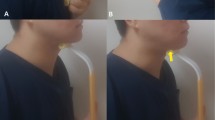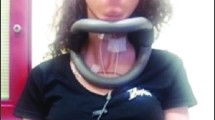Abstract
In this study, the efficacy of two dysphagia interventions, the Chin Tuck against Resistance (CTAR) and Shaker exercises, were evaluated based on two principles in exercise science—muscle-specificity and training intensity. Both exercises were developed to strengthen the suprahyoid muscles, whose contractions facilitate the opening of the upper esophageal sphincter, thereby improving bolus transfer. Thirty-nine healthy adults performed two trials of both exercises in counter-balanced order. Surface electromyography (sEMG) recordings were simultaneously collected from suprahyoid muscle group and sternocleidomastoid muscle during the exercises. Converging results using sEMG amplitude analyses suggested that the CTAR was more specific in targeting the suprahyoid muscles than the Shaker exercise. Fatigue analyses on sEMG signals further indicated that the suprahyoid muscle group were equally or significantly fatigued (depending on metric), when participants carried out CTAR compared to the Shaker exercise. Importantly, unlike during Shaker exercise, the sternocleidomastoid muscles were significantly less activated and fatigued during CTAR. Lowering the chin against resistance is therefore sufficiently specific and intense to fatigue the suprahyoid muscles.


Similar content being viewed by others
Notes
The term ‘suprahyoid muscles’ used in this paper refers to suprahyoid muscle group. For textual fluidity, ‘suprahyoid muscles’ is also used.
The electrode position for the sternocleidomastoid muscle is also generally consistent with Falla et al.’s (2002) recommendations [42]. The placement is perpendicular to the one-third distance from the sternal notch.
The use of a 50 Hz notch filter may shift the median frequency measures to slightly higher frequencies. However the filter was applied to all conditions and participants, making a potential frequency shift identical across conditions, and therefore would not affect differences between the conditions [43]. Previously published studies on muscle fatigue have also employed the 50 Hz notch filter [44, 45].
References
Burkhead LM. Applications of exercise science in dysphagia rehabilitation. In: SIG 13 Perspectives on Swallowing and Swallowing Disorders (Dysphagia), vol.18, 2009; pp. 43–8. doi:10.1044/sasd18.2.43.
Sargeant AJ. Human power output and muscle fatigue. Int J Sports Med. 1994;15(3):116–21. doi:10.1055/s-2007-1021031.
Shaker R, Kern M, Bardan E, Taylor A, Stewart ET, Hoffmann RG, Arndorfer RC, Hoffmann C, Bonnevier J. Augmentation of deglutitive upper esophageal sphincter opening in the elderly by exercise. Am J Physiol. 1997;272(6 Pt 1):G1518–22.
Yoon WL, Khoo JKP, Rickard Liow SJ. Chin Tuck against Resistance (CTAR): new method for enhancing suprahyoid muscle activity using a Shaker-type exercise. Dysphagia. 2014;29(2):243–8. doi:10.1007/s00455-013-9502-9.
Kern M, Hofmann C, Bardan E, Ren J, Arndorfer R, Shaker R. Comparison of upper esophageal sphincter opening in healthy asymptomatic young and elderly volunteers. Ann Otol Rhinol Laryngol. 1999;108(10):982–9. doi:10.1177/000348949910801010.
Cook IJ, Dodds WJ, Dantas RO, Massey B, Kern MK, Lang IM, Brasseur JG, Hogan WJ. Opening mechanisms of the human upper esophageal sphincter. Am J Physiol. 1989;257(5 Pt 1):G748–59.
Pearson WG Jr, Langmore SE, Zumwalt AC. Evaluating the structural properties of suprahyoid muscles and their potential for moving the hyoid. Dysphagia. 2011;26(4):345–51. doi:10.1007/s00455-010-9315-z.
Crary MA, Carnaby GD, Groher ME. Biomechanical correlates of surface electromyography signals obtained during swallowing by healthy adults. J Speech Lang Hear Res. 2006;49(1):186–93. doi:10.1044/1092-4388(2006/015).
Perlman AL, Palmer PM, McCulloch TM, VanDaele DJ. Electromyographic activity from human laryngeal, pharyngeal, and submental muscles during swallowing. J Appl Physiol. 1999;86(5):1663–9.
Goyal RK, Martin SB, Shapiro J, Spechler SJ. The role of cricopharyngeus muscle in pharyngoesophageal disorders. Dysphagia. 1993;8(3):252–8. doi:10.1007/BF01354547.
McConnel FMS, Cerenko D, Jackson RT, Hersh T. Clinical application of the manofluorogram. Larnygoscope. 1988;98(7):705–11. doi:10.1288/00005537-198807000-00003.
Easterling C, Shaker R. UES opening muscle dysfunction. In: Shaker R, Belafsky PC, Postma GN, Easterling C, editors. Principles of deglutition: a multidisciplinary text for swallowing and its disorders. New York: Springer; 2013. p. 529–35.
Autunes EB, Lunet N. Effects of the head lift exercise on the swallow function a systematic review. Gerodontology. 2012;29(4):247–57. doi:10.1111/j.1741-2358.2012.00638.x.
Easterling C. Shaker exercise. In: Shaker R, Easterling C, Belafsky PC, Postma GN, editors. Manual of diagnostic and therapeutic techniques for disorders of deglutition. New York: Springer; 2013. p. 257–68.
Shaker R, Easterling C, Kern M, Nitschke T, Massey B, Daniels S, Grande B, Kazandjian M, Dikeman K. Rehabilitation of swallowing by exercise in tube-fed patients with pharyngeal dysphagia secondary to abnormal UES opening. Gastroenterology. 2002;122(5):1314–21. doi:10.1053/gast.2002.32999.
Logemann JA, Rademaker A, Pauloski BR, Kelly A, Stangl-McBreen C, Antinoja J, Grande B, Farquharson J, Kern M, Easterling C, Shaker R. A randomized study comparing the Shaker exercise with traditional therapy: a preliminary study. Dysphagia. 2009;24(4):403–11. doi:10.1007/s00455-009-9217-0.
Ferdjallah M, Wertsch JJ, Shaker R. Spectral analysis of surface electromyography (EMG) of upper esophageal sphincter-opening muscles during head lift exercise. J Rehabil Res Dev. 2000;37(3):335–40.
Kendall FP, McCreary EK, Provance PG, Rodgers MM, Romani WA. Muscles: testing and function with posture and pain. 5th ed. Philadelphia: Lippincott Williams & Wilkins; 2005.
White KT, Easterling C, Roberts N, Wertsch J, Shaker R. Fatigue analysis before and after Shaker exercise: physiologic tool for exercise design. Dysphagia. 2008;23(4):385–91. doi:10.1007/s00455-008-9155-2.
Easterling C, Grande B, Kern M, Sears K, Shaker R. Attaining and maintaining isometric and isokinetic goals of the Shaker exercise. Dysphagia. 2005;20(2):133–8. doi:10.1007/s00455-005-0004-2.
Forsberg C-M, Hellsing E, Linder-Aronson S, Sheikholeslam A. EMG activity in neck and masticatory muscles in relation to extension and flexion of the head. Eur J Orthod. 1985;7(3):177–84. doi:10.1093/ejo/7.3.177.
Adler SS, Beckers D, Buck M. PNF in practice: an illustrated guide. 4th ed. Berlin: Springer Medizin; 2014.
Williams CA, Ratel S. Definitions of muscle fatigue. In: Williams CA, Ratel S, editors. Human muscle fatigue. Oxon: Routledge; 2009. p. 3–16.
Burd NA, West DWD, Staples AW, Atherton PJ, Baker JM, Moore DR, Holwerda AM, Parise G, Rennie MJ, Baker SK, Phillips SM. Low-load high volume resistance exercise stimulates muscle protein synthesis more than high-load low volume resistance exercise in young men. PLoS One. 2010;5(8):e12033. doi:10.1371/journal.pone.0012033.
Thought Technology. Basics of surface electromyography applied to physical rehabilitation and biomechanics. Montreal: Thought Technology Ltd; 2010.
Thought Technology. BioGraph infiniti [computer software]. Montreal: Thought Technology Ltd; 2009.
MathWorks. MATLAB [computer software]. Natick: MathWorks; 2014.
Crary MA, Groher ME. Basic concepts of surface electromyographic biofeedback in the treatment of dysphagia: a tutorial. Am J Speech-Lang Pathol. 2000;9(2):116–25. doi:10.1044/1058-0360.0902.116.
Konrad P. The ABC of EMG: a practical introduction to kinesiological electromyography. Arizona: Noraxon; 2005.
De Luca CJ. The use of surface electromyography in biomechanics. J Appl Biomech. 1997;13(2):135–63.
Standards for Reporting EMG Data. J Electromyogr Kinesiol 2014; 24(3): I–II. doi:10.1016/S1050-6411(14)00082-0.
Welch PD. The use of fast Fourier transform for the estimation of power spectra: a method based on time averaging over short, modified periodograms. IEEE Trans Audio Electroacoust. 1967;15(2):70–3. doi:10.1109/TAU.1967.1161901.
Basmajian JV, De Luca CJ. Muscles alive: their functions revealed by electromyography. 5th ed. Baltimore: Williams & Wilkins; 1985.
Merletti R, Lo Conte LR, Orizio C. Indices of muscle fatigue. J Electromyogr Kinesiol. 1991;1(1):20–33. doi:10.1016/1050-6411(91)90023-X.
Marwan N, Romano MC, Thiel M, Kurths J. Recurrence plots for the analysis of complex systems. Phys Rep. 2007;438(5–6):237–329. doi:10.1016/j.physrep.2006.11.001.
Farina D, Fattorini L, Felici F, Filligoi G. Nonlinear surface EMG analysis to detect changes of motor unit conduction velocity and synchronization. J Appl Physiol. 2002;93(5):1753–63. doi:10.1152/japplphysiol.00314.2002.
Yassierli, Nussbaum MA. Utility of traditional and alternative EMG-based measures of fatigue during low-moderate level isometric efforts. J Electromyogr Kinesiol. 2008;18(1):44–53. doi:10.1016/j.jelekin.2006.08.003.
Ito K, Hotta Y, Abe T. Detection of muscle fatigue during low-level isometric contraction using recurrence quantification analysis. In: Long M, editor. World congress on medical physics and biomedical engineering, IFMBE Proceedings, vol. 39. Berlin: Springer; 2013. p. 509–12.
Filligoi G, Felici F. Detection of hidden rhythms in surface EMG signals with a nonlinear time-series tool. Med Eng Phys. 1999;21(6):439–48.
Morana C, Ramdani S, Perrey S, Varray A. Recurrence quantification analysis of surface electromyographic signal: sensitivity to potentiation and neuromuscular fatigue. J Neurosci Methods. 2009;177(1):73–9. doi:10.1016/j.jneumeth.2008.09.023.
Cobos AR, Segade LAG, Feutes I. Muscle fibre types in the suprahyoid muscles of the rat. J Anat. 2001;198(3):283–94. doi:10.1046/j.1469-7580.2001.19830283.x.
Falla D, Alba PD, Rainoldi A, Merletti R, Jull G. Location of innervation zones of sternocleidomastoid and scalene muscles—a basis for clinical and research electromyography applications. Clin Neurophysiol. 2002;113(1):57–63. doi:10.1016/S1388-2457(01)00708-8.
Szeto GPY, Straker LM, O’Sullivan PB. EMG median frequency changes in the neck–shoulder stabilizers of symptomatic office workers when challenged by different physical stressors. J Electromyogr Kinesiol. 2005;15(6):544–55. doi:10.1016/j.jelekin.2005.06.004.
Abdul-Latif AA, Cosic I, Kumar DK, Polus B and Da Costa C. Power changes of EEG signals associated with muscle fatigue: the root mean square analysis of EEG bands. In: Proceedings of the 2004 intelligent sensors, sensor networks and information processing conference 2004; pp. 531–4. doi:10.1109/ISSNIP.2004.1417517.
Koumantakis GA, Arnall F, Cooper RG, Oldham JA. Paraspinal muscle EMG fatigue testing with two methods in healthy volunteers. Reliability in the context of clinical applications. Clin Biomech. 2001;16(3):263–6. doi:10.1016/S0268-0033(00)00113-3.
Author information
Authors and Affiliations
Corresponding author
Ethics declarations
Conflict of Interest
The authors declare that they have no conflict of interest.
Appendix: Health Screening Questionnaire
Appendix: Health Screening Questionnaire
Respondent ID: __________________
Please circle Yes or No:
1. Have you ever had any swallowing problem(s)? | Yes/No |
2. Have you ever had a major surgery on or above the neck or on the spine? | Yes/No |
3. Have you ever had any muscle disease(s)? | Yes/No |
4. Have you ever had any heart or lung disease(s)? | Yes/No |
5. Have you ever had a thyroid disease? | Yes/No |
6. Have you ever had a neurological disease? | Yes/No |
7. Have you ever had head injury with loss of consciousness? | Yes/No |
8. Are you on any medication now? If yes, please state: | Yes/No |
Rights and permissions
About this article
Cite this article
Sze, W.P., Yoon, W.L., Escoffier, N. et al. Evaluating the Training Effects of Two Swallowing Rehabilitation Therapies Using Surface Electromyography—Chin Tuck Against Resistance (CTAR) Exercise and the Shaker Exercise. Dysphagia 31, 195–205 (2016). https://doi.org/10.1007/s00455-015-9678-2
Received:
Accepted:
Published:
Issue Date:
DOI: https://doi.org/10.1007/s00455-015-9678-2




